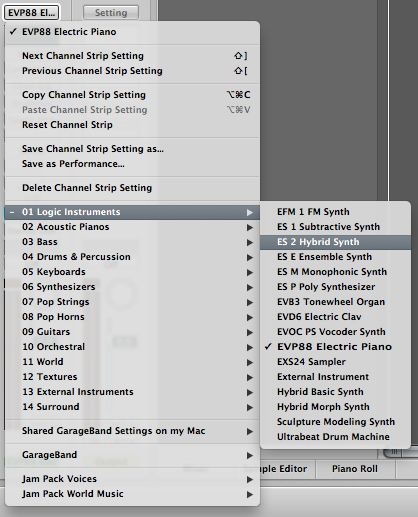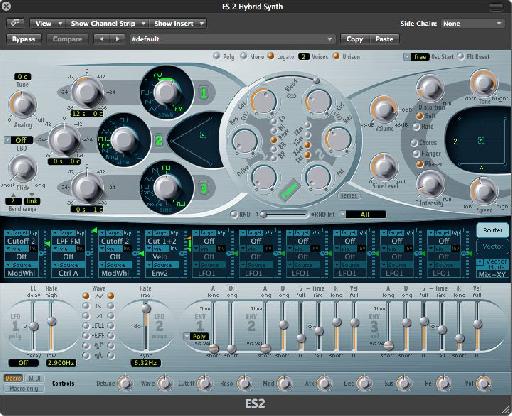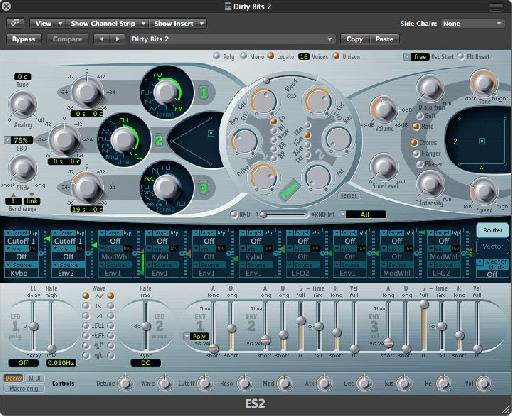Nella parte 2 di questo breve tutorial, ci troveremmo di fronte a come riprodurre un altro suono di un synth pop hit recente, The Black Eyed Peas '"Il Tempo (Dirty Bit)":
Per questo tutorial, useremo Logic ES2 soft-synth per ricreare il suono slinky piombo che arriva alle ore 1:00.
Fase 1 - Impostazione del progetto Logic
La logica aperta, e iniziare con un nuovo progetto vuoto contenente una traccia di strumento software:

Fare clic e tenere premuto il EVP88 strumento di default nella sezione I / O della striscia di canale e scegliere 01

per aprire l'ES default 2 finestra:
Fase 2 - Analizzare il suono
Come sempre, quando si vuole ricreare un suono, abbiamo bisogno di ascoltare attentamente il suono stesso e cercare di capire come è stato messo insieme. In primo luogo, si noti che ci sono due campi nel suono: nella figura giocato con questo suono, il passo superiore scivola su e giù tra A # e B, ma c'è anche un tono più basso dopo il passo superiore di un'ottava e una sotto quinto, volo a vela tra D ed E. # Quindi stiamo andando ad avere bisogno di almeno due oscillatori, e noi vogliamo configurarli in modo che possiamo facilmente scivolare tra le note. Il suono del tono di fondo è un po 'difficile distinguere nel mix, ma sembra essere una semplice forma d'onda. Il passo superiore è dirtierin linea con titleand della canzone sembra avere sia qualche distorsione o qualche altre modulazioni che aggiunge grinta. Vediamo cosa possiamo fare.
Fase 3 - Creare il suono
OK, ecco la mia versione della patch per voi per seguire insieme:
In primo luogo, si noti che ho la gamma Bend a 1, ma mi sembra che questo suono viene riprodotto semplicemente premendo il tasto # e una flessione fino alla B con la ruota passo, poi di nuovo giù di nuovo, più e più volte. Quindi, impostando la gamma Bend a 1, tutto quello che dobbiamo fare per riprodurre il suono viene colpita la A # nel tempo e spingere la ruota tutta la strada fino a raggiungere la B, poi la lasciò cadere di nuovo per la A #.
Avanti, si noti che l'oscillatore 1 viene FM modulata dall'Oscillatore 2, che non è farsi sentire. Sono stato in grado di ottenere una forma d'onda più sporco fuori dell'Oscillatore 1 modulando con un'onda impulso da oscillatore 2. Si noti inoltre che Oscillator 3 è impostato su un triangolo d'onda relativamente mite, ed è accordato un'ottava e una quinta sotto Oscillatore 1. Oscillatori 1 e 3 saranno i nostri superiori e inferiori piazzole, rispettivamente.
Abbiamo anche qualche filtro passa-basso sul mix di oscillatori 1 e 3. Questo stesso filtro viene anche aperto un po 'di più per le note più alte, grazie alla modulazione' KYBD 'fissata per taglio 1 nel primo slot del router, così come da Busta 1, come indicato nello slot 2 del router. A parte questo, la patch è abbastanza semplice. Non ero in grado di ottenere la forma d'onda abbastanza giusto per il suono superiore, ma nel complesso, è abbastanza vicino:
[Audio id = "6946"]
E questo è tutto. Come sempre, ascoltare, sperimentare e divertirsi!
Hai bisogno di una comprensione più profonda di sintesi? Guarda Richard vi porterà attraverso i fondamenti della





 © 2024 Ask.Audio
A NonLinear Educating Company
© 2024 Ask.Audio
A NonLinear Educating Company
Discussion
Little question: if i follow the tutorial and get a sound simmilar to this, can i post the sound here? i mean, in this post? to encourage people to post?
Thanks for this great tutorial!
Glad to know you liked this article - I'll let Richard Lainhart know. The mixing and mastering elements are, of course, beyond the scope of this tutorial - but you've got access to all the tools on this site to add the polish to the sound - which you now know how to program :)
The Hub tutorials don't have a way to host users files yet... but you could host the file on Soundcloud or MySpace or another sharing space and then post the link here...
Best
Rounik
great idea!
of course i hope a lot of people begin to make their own sound.. instead of downloading gigs and gigs of samples and presets from internet!
Thanks Richard.
and i must say Thanks to Steve H. who cure my sample-itis with his great video of the es2 inside-out!...
Actually, even better (and easier to follow) can you post your tips and links in a new thread on the MPV Logic forums?
You can also add images to your posts and URL links more easily on the forums. The Hub isn't yet setup for that purpose.
Really glad to know you've been so inspired by RIchard and SteveH!
Thanks :)
Rounik
Want to join the discussion?
Create an account or login to get started!